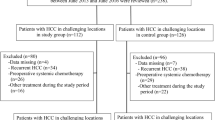Abstract
Background
We aimed to evaluate therapeutic outcomes of radiofrequency (RF) ablation following intra-arterial iodized-oil injection for hepatocellular carcinomas (HCCs) invisible on ultrasonographic (US) images.
Materials and methods
Informed consent was waived for this retrospective study approved by our institutional review board. Sixty-seven consecutive patients with 150 HCCs (mean diameter 1.3 ± 0.6 cm; range 0.5–4.2 cm) received 90 RF sessions following intra-arterial iodized-oil injection. Each patient had at least one HCC invisible on US images. Computed tomography (CT) fluoroscopy-guided RF ablation was performed within 1 week after the injection of iodized oil from feeding arteries of each tumor. Technical success was defined as a planned electrode placement and completion of ablation protocol. Technical success, complications, changes in liver function, local tumor progression, and survival were evaluated.
Results
All HCCs became visible on CT fluoroscopy after iodized-oil injection, and RF ablation was technically successful in all sessions (technical success rate, 100%, 90/90). Major complications occurred in 6 RF sessions (6.7%, 6/90), including hemorrhage (2.2%, 2/90), portal thrombosis (2.2%, 2/90), and pneumothorax (2.2%, 2/90). No significant deterioration in Child–Pugh score was found. The mean follow-up period was 23.2 ± 18.0 months. The cumulative local tumor progression rates and overall survival rates were, respectively, 3.9 and 82.7% at 1 year, 5.3 and 45.3% at 3 years, and 5.3 and 26.4% at 5 years.
Conclusion
CT fluoroscopy-guided RF ablation following intra-arterial iodized-oil injection is a feasible, safe, and useful therapeutic option for HCCs invisible on US images.


Similar content being viewed by others
References
Llovet JM, Bruix J (2008) Novel advancements in the management of hepatocellular carcinoma in 2008. J Hepatol 48:20–37
Shiina S (2009) Image-guided percutaneous ablation therapies for hepatocellular carcinoma. J Gastroenterol 44:122–131
Choi D, Lim HK, Rhim H et al (2007) Percutaneous radiofrequency ablation for early stage hepatocellular carcinoma as a first-line treatment: long-term results and prognostic factors in a large single-institution series. Eur Radiol 17:684–692
Tateishi R, Shiina S, Teratani T et al (2005) Percutaneous radiofrequency ablation for hepatocellular carcinoma. An analysis of 1000 cases. Cancer 103:1201–1209
Lecioni R, Cioni D, Crocetti L et al (2005) Early stage hepatocellular carcinoma in patients with cirrhosis: long-term results of percutaneous image-guided radiofrequency ablation. Radiology 234:961–967
Rhim H, Lee MH, Kim YS et al (2008) Planning sonography to assess the feasibility of percutaneous radiofrequency ablation of hepatocellular carcinomas. AJR 190:1324–1330
Park BJ, Byun JH, Jin YH et al (2009) CT-guided radiofrequency ablation for hepatocellular carcinomas that were undetectable at US: therapeutic effectiveness and safety. J Vasc Interv Radiol 20:490–499
Shibata T, Shibata T, Maetani Y et al (2004) Transthoracic percutaneous radiofrequency ablation for liver tumors in the hepatic dome. J Vasc Interv Radiol 15:1323–1327
Gandhi S, Iannitti DA, Mayo-Smith WW et al (2006) Technical report: lipiodol-guided computed tomography for radiofrequency ablation of hepatocellular carcinoma. Clin Radiol 61:888–891
Kurokohchi K, Deguchi A, Masaki T et al (2007) Successful treatment of hypovascular advanced hepatocellular carcinoma with lipiodol-targeting intervention radiology. World J Gastroenterol 13:4398–4400
Bruix J, Sherman M, Llovet JM et al (2001) Clinical management of hepatocellular carcinoma. Conclusions of the Barcelona-2000 EASL conference. European Association for the Study of the Liver. J Hepatol 35:421–430
Goldberg SN, Grassi CJ, Cardella JF et al (2005) Image-guided tumor ablation: standardization of terminology and reporting criteria. Radiology 235:728–739
Sacks D, McClenny TE, Cardella JF et al (2003) Society of Interventional Radiology clinical practice guidelines. J Vasc Interv Radiol 14:199–202
Koda M, Ueki M, Maeda Y et al (2004) Percutaneous sonographically guided radiofrequency ablation with artificial pleural effusion for hepatocellular carcinoma located under the diaphragm. AJR 183:583–588
Rhim H, Lim HK, Kim YS et al (2008) Percutaneous radiofrequency ablation with artificial ascites for hepatocellular carcinoma in the hepatic dome: initial experience. AJR 190:91–98
Miyamoto N, Hiramatsu K, Tsuchiya K et al (2009) Sonazoid-enhanced sonography for guiding radiofrequency ablation for hepatocellular carcinoma: better tumor visualization by Kupffer-phase imaging and vascular-phase imaging after reinjection. Jpn J Radiol 27:185–193
Krücker J, Xu S, Glossop N et al (2007) Electromagnetic tracking for thermal ablation and biopsy guidance: clinical evaluation of spatial accuracy. J Vasc Interv Radiol 18:1141–1150
Takaki H, Yamakado K, Nakatsuka A et al (2007) Radiofrequency ablation combined with chemoembolization for the treatment of hepatocellular carcinomas 5 cm or smaller: risk factors for local tumor progression. J Vasc Interv Radiol 18:856–861
Yamakado K, Nakatsuka A, Ohmori S et al (2002) Radiofrequency ablation combined with chemoembolization in hepatocellular carcinoma: treatment response based on tumor size and morphology. J Vasc Interv Radiol 13:1225–1232
Sugimori K, Nozawa A, Morimoto M et al (2005) Extension of radiofrequency ablation of the liver by transcatheter arterial embolization with iodized oil and gelatin sponge: results in a pig model. J Vasc Interv Radiol 16:849–856
Kang SG, Yoon CJ, Jeong SH et al (2009) Single-session combined therapy with chemoembolization and radiofrequency ablation in hepatocellular carcinoma less than or equal to 5 cm: a preliminary study. J Vasc Interv Radiol 20:1570–1577
Livraghi T, Solbiati L, Meloni MF et al (2003) Treatment of focal liver tumors with percutaneous radio-frequency ablation: complications encountered in a multicenter study. Radiology 226:441–451
de Baère T, Risse O, Kuoch V et al (2003) Adverse events during radiofrequency treatment of 582 hepatic tumors. AJR 181:695–700
Kong WT, Zang WW, Qiu YD et al (2009) Major complications after radiofrequency ablation for liver tumors: analysis of 255 patients. World J Gastroenterol 15:2651–2656
Yamakado K, Nakatsuka A, Takaki H et al (2010) Subphrenic versus nonsubphrenic hepatocellular carcinoma: combined therapy with chemoembolization and radiofrequency ablation. AJR 194:530–535
Conflict of interest
The authors declare that they have no conflict of interest.
Author information
Authors and Affiliations
Corresponding author
About this article
Cite this article
Takaki, H., Yamakado, K., Nakatsuka, A. et al. Computed tomography fluoroscopy-guided radiofrequency ablation following intra-arterial iodized-oil injection for hepatocellular carcinomas invisible on ultrasonographic images. Int J Clin Oncol 18, 46–53 (2013). https://doi.org/10.1007/s10147-011-0340-1
Received:
Accepted:
Published:
Issue Date:
DOI: https://doi.org/10.1007/s10147-011-0340-1




